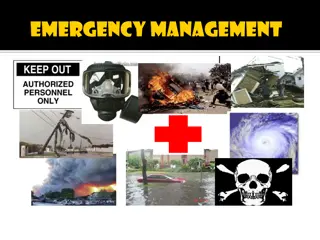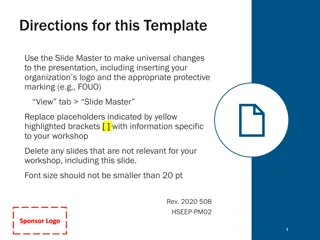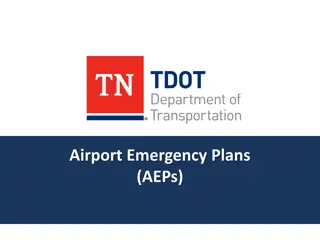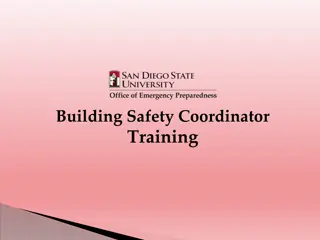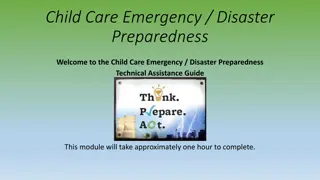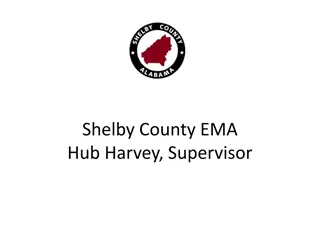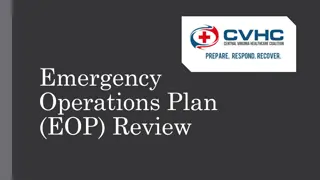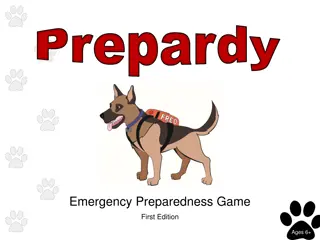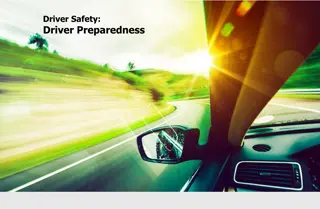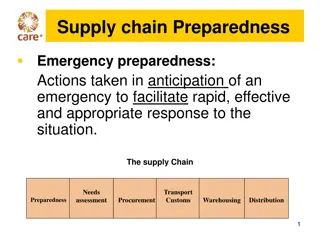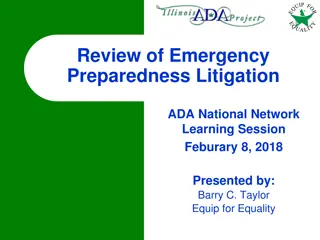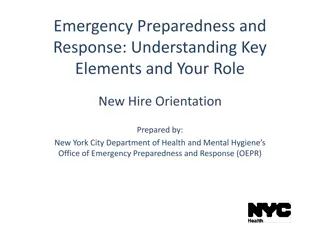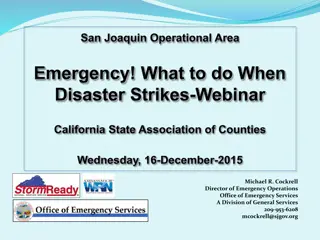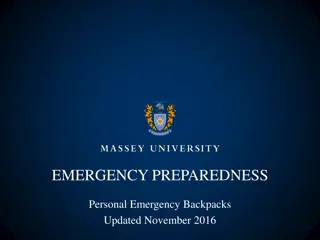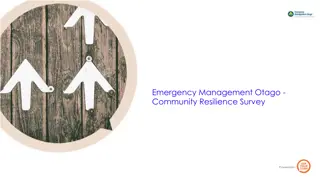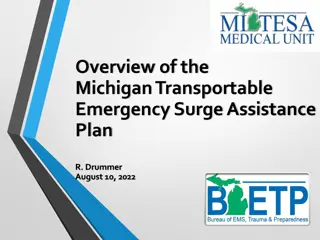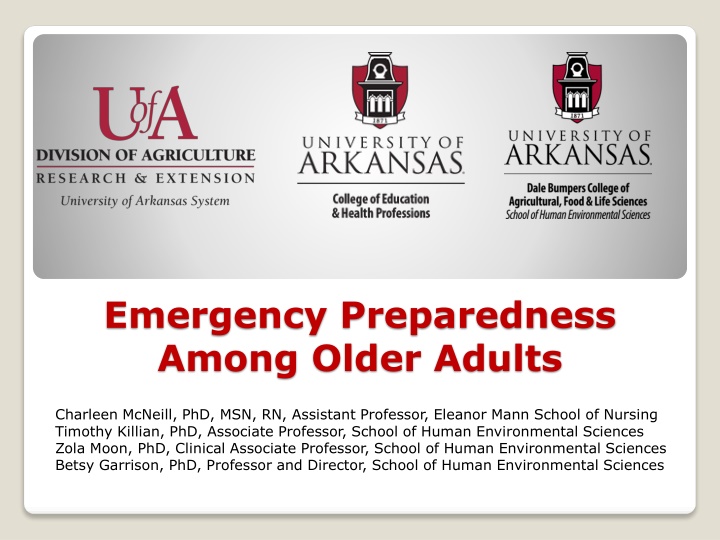
Emergency Preparedness Among Older Adults - Steps, Supplies & Tips
Discover the essential steps for emergency preparedness among older adults, including creating a kit, making a plan, and staying informed. Learn what supplies to include in your kit and additional items for comprehensive preparedness. Be proactive and ensure readiness for any potential emergencies or disasters.
Uploaded on | 1 Views
Download Presentation

Please find below an Image/Link to download the presentation.
The content on the website is provided AS IS for your information and personal use only. It may not be sold, licensed, or shared on other websites without obtaining consent from the author. If you encounter any issues during the download, it is possible that the publisher has removed the file from their server.
You are allowed to download the files provided on this website for personal or commercial use, subject to the condition that they are used lawfully. All files are the property of their respective owners.
The content on the website is provided AS IS for your information and personal use only. It may not be sold, licensed, or shared on other websites without obtaining consent from the author.
E N D
Presentation Transcript
Emergency Preparedness Among Older Adults Charleen McNeill, PhD, MSN, RN, Assistant Professor, Eleanor Mann School of Nursing Timothy Killian, PhD, Associate Professor, School of Human Environmental Sciences Zola Moon, PhD, Clinical Associate Professor, School of Human Environmental Sciences Betsy Garrison, PhD, Professor and Director, School of Human Environmental Sciences
Objectives Understand how to become more prepared for emergencies Remember what items are needed Learn the steps to becoming prepared Apply aspects of preparedness to people with chronic diseases Apply aspects of preparedness to people with special needs
Three Steps to Preparedness Get a Kit Make a Plan Be Informed
Get a Kit At least three days worth of supplies needed. Store your supplies in one or more easy-to-carry containers. Consider storing supplies in a container that has wheels. Be sure your bag has an ID tag. Label any equipment that you would need with your name, address and phone numbers. Keep your kit up-to-date.
What Supplies Should be in Your Kit? Water Food Flashlight with extra batteries and bulbs Battery-operated or hand-crank radio (NOAA Radio) First aid kit and manual Medications (7-day supply) and medical items Multi-purpose tool Sanitation and personal hygiene items Copies of personal documents Cell phone with an extra battery and charger (s) Family and friends emergency contact information Cash and coins Emergency blanket Map(s) of the local area Whistle One change of clothing Manual can opener Pet supplies if you have pets (including food, water and vaccination records) Extra set of keys (car, house, etc.) Pack of cards to provide entertainment and pass the time Dust mask Moist towelettes, garbage bags, plastic ties for personal sanitation Wrench or pliers to turn off utilities
Additional Supplies for Your Kit Glasses Infant formula and diapers Emergency reference materials Sleeping bag or warm blanket Chlorine bleach and medicine dropper Fire extinguisher Matches in water proof container Mess kits, paper cups, plates, paper towels, plastic utensils Paper and pencil Books, games, puzzles
Older Adults: What Else Should be in the Kit? Personalized emergency plans Where to go How to get there Who should be called for help What should be brought with them Hearing aids and extra batteries Oxygen Assistive devices List of health care providers and pharmacies in water proof bag Include provisions to transport devices Keep backup list of emergency information in another location
Cold Weather Supplies Jacket or coat Long pants and long-sleeve shirt Sturdy shoes Hat, mittens and scarf Sleeping bag or warm blanket
Supplies for Your Vehicle Flashlight with extra batteries and extra bulbs Maps First aid kit and manual Tire repair kit Jumper cables Flares Bottled water Non-perishable foods Winter Summer
Make a Plan Meet with Your Family and Friends Family Communications Plan Community Disaster Plans Escape Routes and Meeting Places Post emergency phone numbers near your phones Plan for those with disabilities Plan for your pets or service animals Utilities Smoke alarms and carbon monoxide alarms Insurance coverage Vital records and documents Hearing aids/Cochlear implants
Be Informed Community hazard assessment Community warning systems Local neighborhood emergency teams Local volunteer fire departments Local EAS (Emergency Alert System) NOAA Weather Radio/All-Hazard Alert Radio Door-to-door warning from local emergency officials Senior living and assisted living communities Be aware help inform others
When Disaster Strikes Sheltering in place vs. staying at home If you need to evacuate Public shelters Services provided at a Red Cross shelter Immediately after a disaster If electrical power is lost Financial exploitation/scams Before a fire In case of fire Grandparents and grandchildren Children can help grandparents too Home caregivers special considerations
Information on Shelters Opened when a disaster affects a large number of people Opened when a disaster is expected to last several days Meals, water, personal hygiene items, first aid, and information You must bring your own bedding, medications, special need items Pets are not allowed Many older adults are overwhelmed by shelters. Older adults with arthritis may find it difficult to sleep there Those with dementia may become agitated Older Adults with chronic conditions may face health risks
Information on Special Needs Shelters For medically dependent residence Must bring own medications, medical devices, bedding, food Caregiver must remain with resident Few accessible bathrooms No shower facilities No Privacy Should be considered a last resort Staffed by medical personnel, social workers, and administrative staff Inspected by public health specialists
Family Members in Long Term Care Facilities Inquire about the facility s disaster planning What emergency plans are in place? How does the facility define an emergency? Are sufficient supplies and generators available? When will evacuation occur? How will evacuation be carried out? Who will notify families that a resident has been evacuated?
General Preparedness Considerations for Seniors Preparation and planning Evaluate your own personal needs Create a network of people to aid you in an emergency Discuss your needs Keep specialized items ready Make provisions for medications that require refrigeration Make arrangements for any assistance to get to shelters
Individuals with Disabilities and Others with Access and Functional Needs How to make a plan and create a support network Step 1. Collect Information Step 2. Share your emergency plans Step 3. Practice your plan with your support network
Individuals with Disabilities and Others with Access and Functional Needs Power outage plans Deaf or Hard of Hearing Blind or low vision Speech disability Mobility disability Service animals
Chronic Disease Considerations Kidney Disease Kidney Disease Consideration Emergency phone numbers for doctors and dialysis centers At least 3 days worth of medicines Diabetes For those who rely on automated peritoneal dialysis, perform manual exchange The 3 day emergency diet Widespread outages Evacuating to a shelter Individual emergencies
Chronic Disease Considerations Diabetes Diabetes General preparedness items Glucose gel or small amounts of juice and hard candy Protein bars Diabetes supplies Monitor blood sugars Treat low blood sugars (less than 70 mg/dl) Keep insulin safe
Chronic Disease Considerations COPD Chronic Obstructive Pulmonary Disease Notify local fire station and power company if you are on oxygen Put together an emergency kit Nebulizing equipment Periodically check on power Keep ice remover Install remote starter on car Have someone clear your drive way Purchase small generator Notify ambulance services Check exterior lights Keep driveway clear
Considerations for Caregivers Dementia/Alzheimer s A recent picture of the person with dementia Advance preparations Emergency kit If you know a disaster is about to occur During an evacuation Tips for preventing agitation Helpful hints during an episode of agitation Take care of yourself
Review and Wrap-up Get a kit Ensure your kit is labeled with your name Consider containers with wheels Ensure you have anything needed for mobility aids Ensure you have anything needed for chronic disease Make a plan Plan for shelter in place and evacuation Plan for pets Be sure to practice your plan Plan for those with disabilities and chronic diseases Be informed Know what disasters are likely in your area Know your neighbors and your community
References American Red Cross. (n.d.). Disaster preparedness for seniors by seniors. Retrieved from http://www.redcross.org/images/MEDIA_CustomProductCatalog/m4640086_Disaster_Preparedness_for_Srs- English.revised_7-09.pdf Centers for Disease Control and Prevention. (2017). Disaster planning tips. Retrieved from https://www.cdc.gov/aging/pdf/disaster_planning_ tips.pdf Federal Emergency Management Agency. (2017). Shelter. Retrieved from https://www.ready.gov/shelter Federal Emergency Management Agency. (2017). Seniors. Retrieved from https://www.ready.gov/seniors Federal Emergency Management Agency. (2017). Access and functional needs. Retrieved from https://www.ready.gov/individuals-access-functional-needs Davita. (2017). Emergency preparedness for people with kidney disease. Retrieved from https://www.davita.com/kidney-disease/overview/living-with-ckd/emergency-preparedness-for-people-with-kidney- disease/e/4930 Davita. (2017). Diabetes emergency plan: Are you ready? Retrieved from https://www.davita.com/kidney- disease/causes/diabetes/diabetes-emergency-plan:-are-you-ready?/e/6943 Mi, Carolyn. (n.d.) A helpful list for emergency situations. Retrieved from http://copdandsomuchmore.com/carolynemergency.html Alzheimer s Association. (2017). In a disaster. Retrieved from https://www.alz.org/care/alzheimers-dementia- disaster-preparedness.asp Alzheimer s Association. (2017). Emergency preparedness. Retrieved from http://www.alz.org/national/documents/topicsheet_disasterprep.pdf

